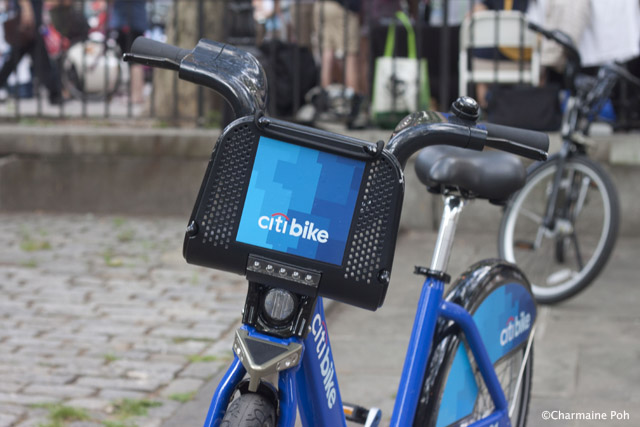
Citi Bike’s 2013 debut was hailed as the next best thing to hit the streets of the New York since Uber cabs. The bike share system, which currently serves Manhattan below 60th Street and portions of Brooklyn, has become tremendously popular among its 93,000 annual members and 288,000 one-time daily users. However, Citi Bike faces a major obstacle in becoming a truly accessible and equitable transportation option for all New Yorkers. Social activists are increasingly attacking Citi Bike for its failure to serve low-income communities of color and outer-borough populations. Their social justice critique is sure to carry more weight with a new De Blasio administration keen on tackling New York’s glaring levels of inequality.
A primary critique of Citi Bike is that the spatial distribution of stations effectively prevents low-income New Yorkers from accessing the system. Similar to its peer bike share systems around the world, Citi Bike’s initial coverage area is largely of desirable, centrally located, transit-rich neighborhoods that are less diverse and more affluent than the City at large. It’s easy to see how commuters from Harlem, Brighton Beach, or Jackson Heights might dismiss Citi Bike as a twee fad of the City’s ‘one percent’ rather than a useful transportation option.
New York City DOT outlined plans for the expansion of Citi Bike to the outer boroughs in a 2009 feasibility study, with Phases Two and Three of the program serving most areas of the Bronx, Queens, and Brooklyn. But this goal of expansion has hit a major snag: CitiBank, the major financier of Citi Bike whose advertising regales every bike and docking station in the system, has withdrawn support from the program since its initial $47 million in seed funding. DOT did secure some post-Sandy federal funding for a Citi Bike expansion to Long Island City, Crown Heights, and eastern Bed-Stuy. But after 2014, there is no new funding on the horizon.
The City now finds itself in the awkward position of being essentially unable to expand the highly popular Citi Bike system, despite the fact that the program is self-sufficient through its user fees. Unless Citi Bike can expand its geography to low-income areas in the outer boroughs, its effectiveness as a transportation choice for New Yorkers is limited.
The high cost of membership is Citi Bike’s second major road block. As an anti-theft measure, Citibike requires a temporary credit card security deposit of $101 to purchase daily or weekly passes (versus $95 for an annual membership). While this pricing model is effective in tying each bike to a specific person, requiring a credit card explicitly discriminates against low-income people who are less likely to have bank accounts or credit cards.
To resolve this inequity, Citibike made public outreach efforts to locate stations within one block of all 29 NYCHA properties in the coverage area. In addition, Citibike has offered discounted $60 memberships to NYCHA residents. However, this discounted membership has inspired only a minuscule participation rate among NYCHA residents. According to a recent story in DNAInfo, only 285 NYCHA residents are Citi Bike members, or about 0.5% of the total. Justin Ginsburg of NYC Bikeshare (a subsidiary of Alta Bikeshare) described the typical Citi Bike user as a White male earning a six-figure income.
That Citi Bike’s core demographic consists of affluent men in posh neighborhoods was expected from DOT’s demand model, since Manhattan and western Brooklyn neighborhoods have the highest density of retail, transit, and tourist destinations to generate enough ridership to make the program self-sufficient. Unless Citi Bike actively expands its service area, however, it will miss out on attracting riders from low-income neighborhoods where the service is desperately needed. Evidence from London’s bike share should serve as a cautionary tale. Only 15.9% of London’s bike share users are from the UK’s lowest-income quintile, compared with 32.6% of the city at large. Low-income users of London’s bike share program made more frequent and more utility-oriented trips than affluent users, which suggests a high latent demand for bike share stations in low-income communities that currently lack them.
In order to truly serve all New Yorkers, Citi Bike must expand to the outer borough neighborhoods identified in Phases Two and Three of the DOT feasibility study. These are areas like the South Bronx, Harlem, Coney Island, Bushwick, and Sunset Park which have high population and transit densities but not the resident wealth to field self-sustaining bike share systems on their own.
Expansion of the Citibike system to low-income communities of color is vital to fulfill its key objective of expanding cycling mode share citywide. Unfortunately, Citi Bike is operated as a public-private partnership, where the City has little actual control of the program’s day-to-day operations and misses out on a large portion of the advertising revenues. With no major funding on the horizon beyond 2014, the City must make a fundamental choice about Citi Bike’s future: is it a niche program for the well-heeled, or is it a bona fide transportation option to complement the MTA’s subway and bus service?
So how can Citi Bike expand to the outer boroughs and become a viable transportation program serving all New Yorkers? See four recommendations next:





